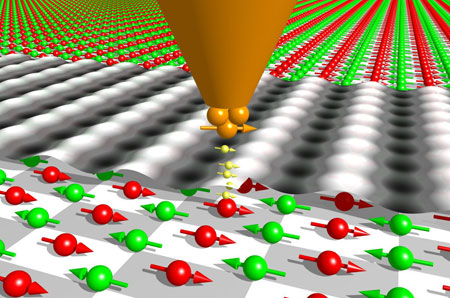

Research Program
Spintronics is the field of research that explores the electron spin in solid state systems. The main impact came from improvements in metal epitaxy: The ability to grow thin films and multilayer systems with high-quality interfaces paved the way for the discovery of interlayer magnetic exchange coupling and subsequently the giant magnetoresistance effect (GMR) by Albert Fert and Peter Grünberg (Nobel Prize in Physics 2007). Within the framework of the proposed Cluster NANO-SPINTRONICS various complementary experimental methods to fabricate and probe smart nanoscale systems for spintronic applications will be applied. Tools available for nanostructuring include electron beam lithography, focused ion beam techniques, molecular beam epitaxy of self-assembled nanostructures, and atomic manipulation based on scanning probe methods. The nanoscale magnetic systems will be investigated at ultra-short time and atomic length scales, making use of a unique combination of experimental methods available at the University of Hamburg and at the two large-scale research facilities, DESY and GKSS. Moreover, a close interdisciplinary cooperation between experimental and theory groups from different Departments of the University of Hamburg as well as from DESY and GKSS will provide a unique framework for cutting-edge research and education in one of the most active fields of condensed matter research. As an ultimate scientific goal of our Cluster, we wish to explore the atomistic spin-dependent interactions and processes in order to create a sound basis for the development of future nanoscale spintronic devices. We will focus on three different classes of materials for spintronic applications: Metal-based systems (research area A), semiconductor-based systems and metal-semiconductor hybrids (research area B) as well as molecular- and atomic-based systems (research area C). While many previous investigations of metal-based spintronic systems have focused on magnetic ultrathin films and multilayer systems, our focus within research area A will be on laterally confined systems, covering length scales from some hundred nanometers down to the single-digit nanometer scale. We will focus on static as well as dynamic magnetic properties as function of the lateral scale and will study the crossover between systems which can still be described within micromagnetic theory and systems which are governed by their atomic structure and by quantum effects. A major hurdle for realistic applications of dilute magnetic semiconductors is still their relatively low Curie temperature as well as the strong disorder. The spin polarization at the interface of metal-semiconductor hybrids and the control of ferromagnetism in semiconductors are the central topics in research area B. They require a detailed understanding of the heterointerface and the interaction between magnetic dopants at the atomic level. The role of strain and disorder in the systems will be adressed as one of the key questions. In the field of molecular systems (area C) the discovery of various classes of magnetic molecules has attracted great scientific interest in the past twenty years and has led to many fascinating experiments, e.g., the demonstration of quantum tunnelling and interference in magnetization dynamics. While most experiments in this particular field have been performed with molecular crystals or molecules in solution, it still remains a challenge to prepare high-quality thin films of magnetic molecules or even single magnetic molecules in well-defined electronic and spin states on solid substrates as a sound starting point for future spin-based molecular devices. In this field, a close interaction between research groups from chemistry and physics is of utmost importance |

Our initiative builds upon existing Centers of Excellence, including two DFG Collaborative Research Centers (SFB508 "Quantum Materials" and SFB668 "Nanomagnetism") and three DFG Research Training Groups (GrK 611,1247,1286). While the SFB 668 is focussed on metal-based magnetic nanostructures and their static and dynamic properties, the SFB 508 has partially covered the area of semiconductor-based spintronics. Molecular-based spintronic systems are currently being investigated to a small extent within the framework of the SFB 668 and GrK 611. With the present initiative of establishing a Cluster of Excellence in the field of NANO-SPINTRONICS we intend to bring together the complementary expertise of research groups in various scientific disciplines and at different research institutions. In particular, we wish to establish strong links between research groups of the University of Hamburg and groups working at DESY and GKSS, which have not been involved yet in the above mentioned cooperative research programmes. Moreover, we would like to bring in the expertise from the Departments of Mathematics and Informatics for the theoretical treatment and modeling of spintronic systems and devices, as well as for new developments in the fields of automated nanostructuring and device design. |





